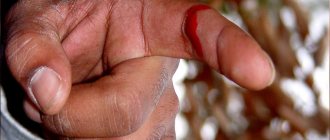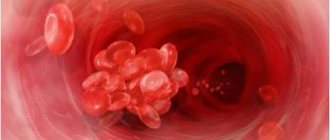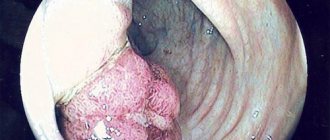Arterial bleeding: signs and differences
There are three types of bleeding: arterial, venous and capillary. Bleeding can also be divided into external and internal, but further we will talk about external bleeding, since internal bleeding can only be eliminated in a hospital setting. Arterial bleeding occurs when the arteries—the vessels through which oxygenated blood flows from the heart to the organs and tissues—are damaged. Venous bleeding occurs when the integrity of the veins, the vessels through which blood enriched with carbon dioxide flows from organs and tissues to the heart, is damaged. Capillary bleeding - when small vessels are damaged, through which gas exchange of oxygen and carbon dioxide occurs.
External differences between arterial and venous bleeding
Arterial blood is rich in oxygen and has a rich scarlet-red color, in contrast to venous blood, which is darker, closer to burgundy. With venous bleeding, blood slowly flows out of the damaged vein. The pressure in the arteries is much higher than in the veins, this is due to contractions of the left ventricle, which pumps blood throughout the body, so if the artery is damaged, the blood is released very quickly, in a characteristic pulsating stream. Such bleeding is life-threatening.
The risk of developing massive bleeding is assessed, among other things, by determining PCT in a blood test:
Pressing the vessel with your fingers
These methods of stopping arterial bleeding are used when the following vessels are damaged:
- Carotid artery.
- Femoral artery.
- Subclavian artery.
- Axillary artery.
- Brachial artery.
Using the thumb or four fingers, the vessel is pressed against the protrusion of the bone above the area of damage. There should be no pulse below the pressure point. You need to know the points in advance by practicing on yourself or your partner.
- The carotid artery is pressed against the spine on the side of the larynx.
- The femoral artery is pressed against the protrusion of the pelvic bone in the inguinal fold, grasping the root of the limb with both hands.
- The subclavian artery is pressed, placing the thumb behind the collarbone as much as possible.
- The shoulder is pressed for bleeding from the lower third of the shoulder and below. The pressure point is the inner side of the shoulder under the biceps.
It is important to remember that finger pressure is difficult to perform for a long time. Therefore, after stopping the bleeding, apply a tourniquet or, in its absence, a twist using improvised means.
First Aid Basics
Places where arteries are pressed during bleeding
The basic rules are determined by the anatomical features of a person. Since blood flows through the arteries from the heart, it is advisable to press the artery above the site of injury. However, this rule does not apply to wounds in the neck and head; in this case, pressure is applied below the area of injury. It is necessary to press the artery to the bone, since the arteries are very elastic and can easily slip away from you in the soft tissues, without having any “support” under them. If the arteries of the extremities are damaged, they can be elevated.
Try to roughly determine the amount of blood loss; in the future, these data will help doctors in treatment.
The table indicates pressure points for bleeding from specific arteries.
| Artery | Pressure point |
| Temporal artery | Temporal bone |
| External maxillary artery | Lower jaw |
| Carotid artery | 7th cervical vertebra |
| Subclavian artery | Inner surface of the clavicle |
| Axillary artery | Head of humerus |
| Brachial artery | Humerus, inner surface, under the biceps |
| Ulnar artery | Ulna, along the anterior surface of the forearm, on the little finger side |
| Radial artery | Radius bone, along the anterior surface of the forearm, on the side of the thumb |
| Femoral artery | Femur |
| Popliteal artery | Tibia, along the back of the leg |
| Posterior tibial artery | Tibia, along the inner surface of the lower leg |
| Arteries of the dorsum of the foot | Tarsal bones of the foot, along the anterior surface |
Basic methods of temporary and final stop of bleeding.
⇐ PreviousPage 2 of 37Next ⇒Methods for temporarily stopping bleeding include: wound tamponade and application of a pressure bandage, maximum flexion of the limb in the joint, elevated position of the limb, digital pressure of the artery throughout and in the wound, application of a clamp to the bleeding vessel in the wound, application of a tourniquet, temporary bypass of the vessel.
Wound tamponade and applying a pressure bandage are the simplest and most effective ways to temporarily stop bleeding from veins, small arteries and capillaries - pressing the vessel directly at the site of injury with a tightly applied bandage reduces the lumen of the vessel, promotes thrombosis and prevents the development of a hematoma. This method of hemostasis must be combined with immobilization and elevated position of the limb above body level.
Maximum flexion of a limb in a joint is based on bending the limb to failure in the joint lying above the wound - elbow, knee and hip, and fixing it with a bandage or improvised material.
Finger pressure of the artery along its length is based on pressing the superficially located arterial vessel to the nearby bones of the skeleton above the site of bleeding in case of wounds to the vessels of the limb and below the wound in case of injuries to the vessels of the neck.
— The carotid artery can be pressed against the carotid tubercle of the transverse process of the VI cervical vertebra.
- The subclavian artery is compressed, pressing it to the first rib at a point located above the collarbone, immediately outward from the place of attachment of the sternocleidomastoid muscle to the manubrium of the sternum, while the patient’s arm is retracted downwards and backwards.
— The axillary artery is easily pressed in the axilla to the head of the humerus.
— the brachial artery is pressed against the inner surface of the humerus at the inner edge of the biceps muscle.
—The femoral artery presses against the pubic bone at a point immediately inferior to the Pupartian ligament, midway between the anterior superior iliac spine and the symphysis.
An effective way to temporarily stop bleeding is to apply a hemostatic clamp to a bleeding vessel in a wound; this can only be done in the operating room; however, you cannot apply the clamp to the vessel blindly: firstly, it is ineffective, and secondly, it can damage nearby nerves and the artery itself.
Temporary vessel bypass (temporary intravascular replacement). A prosthetic tube is inserted into both ends of the damaged vessel, and the ends of the vessel are fixed to the prosthesis with ligatures. With the help of shunts inserted into the lumen of damaged arteries and veins, it is possible to maintain temporary blood flow for 6-24 hours or more. Temporary prosthetics can be external (external), internal and lateral. Tubes made of various materials are used as temporary prostheses; preference is given to prostheses made of silicone - a material that is chemically inert, durable, has water-repellent and athrombogenic properties, is easily sterilized, and is securely fixed in the lumen of a damaged vessel.
Applying a tourniquet is the most reliable method of temporarily stopping bleeding. The principle of stopping bleeding is based on pressing the main arterial trunk along with soft tissues to the bone.
Methods for finally stopping bleeding. The final stop of bleeding can be mechanical, physical, chemical and biological.
Mechanical methods of stopping bleeding are performed in the dressing room or operating room during surgical treatment of a wound or during surgery and consist of the following: a) clamping the vessel with a clamp followed by application of a ligature; b) in case of danger of the ligature slipping, they use the method of puncturing the vessel, i.e., before tying, the thread is passed through the wall of the vessel or the surrounding tissue with a surgical needle and then passed around the vessel and tied; c) ligation of the vessel along its length.
In case of diffuse bleeding from a wound, when it is impossible to stop the bleeding even by suturing the tissues in the mass, the method of ligating the vessel feeding this area throughout is used. To do this, the vessel is exposed with a separate incision above the wound and bandaged. The ideal way to stop bleeding when large vessels are damaged is a vascular suture, which restores the continuity of the vascular bed. A necessary condition for applying a vascular suture is the presence of vascular clamps, atraumatic needles and the surgeon’s knowledge of the vascular suture technique.
Physical ways to stop bleeding include the use of high and low temperatures. The hemostatic effect of high temperature is based on its contracting effect on the vessel, and at significant levels, tissue proteins and blood coagulate. For this purpose, an isotonic sodium chloride solution is most often used, heated to 45-50 ° C. Currently, electrocoagulation has become widespread - one electrode of the coagulator in the form of a lead plate is tightly fixed to the limb through a gauze moistened with an isotonic sodium chloride solution, the second the electrode is free, and when it touches the hemostatic clamp, coagulation of the vessel occurs. In medical practice, a laser beam has begun to be used as a scalpel, which allows bloodless surgery. Low temperature acts similarly to high temperature, causing spasm or tissue coagulation depending on the magnitude. For this purpose, ice, crystallized carbon dioxide (dry ice), and liquid nitrogen are used.
Chemical methods are divided into external and internal hemostatic agents. As an external agent, a 3-5% solution of hydrogen peroxide, a solution of adrenaline 1:1000, etc. are used. Internal agents consist of two groups: those that cause vascular contraction (ergot preparations, adrenaline, norepinephrine, mesaton, etc.) and those that increase blood clotting (vicasol, calcium chloride, gelatin, aminocaproic acid, hemophobin, etc.).
Biological methods of stopping bleeding are based on the external and internal use of blood products and its components (hemostatic sponge, fibrin film, fractional transfusion of small doses of blood, fibrinogen, fresh plasma).
General principles of primary surgical treatment of wounds. PSO of a wound is the first surgical intervention on a victim, performed according to primary indications, due to the nature of the wound, in order to prevent wound infection. PST of wounds is performed within 24 (48 hours) after injury. Early PST is carried out up to 12 hours without the use of antibiotics or up to 24 hours with the use of antibiotics. Delayed PST of a wound is carried out for up to 24 hours without the use of antibiotics or 48 hours with the use of antibiotics, and ends with the application of primary sutures. First, you need to wash the wound with an antiseptic solution, then remove foreign bodies, treat the edges of the wound with an antiseptic solution and place sterile linen around the wound. PSO technique: anesthesia, wound dissection, wound revision, excision of skin edges, walls and bottom of the wound with removal of crushed tissue. The thickness of the layer of tissue removed is from 0.1-0.5 to 2.0 cm. Next, hemostasis is carried out. According to indications - wound drainage. Solve the issue of suturing. Emergency prevention of tetanus is carried out after determining the titer of antitetanus antibodies in the blood.
Transplantation of organs and tissues. Transplantation is the transplantation of any organ or tissue.
Classification of transplantations depending on the type of donor.
1) Autotransplantation - organ transplantation within the same organism (donor and recipient are simultaneously the same person).
2) Isotransplantation - a transplant is carried out between two genetically identical organisms (identical twins). Such operations are rare, since the number of identical twins is small, and in addition, they often suffer from similar chronic diseases.
3) Allotransplantation (homotransplantation) - a transplant between organisms of the same species (from person to person) having a different genotype. This is the most commonly used type of transplant. It is possible to collect organs from relatives of the recipient, as well as from other strangers.
4) Xenotransplantation (heterotransplantation) - an organ or tissue is transplanted from a representative of one species to another, for example, from an animal to a person. The method has received extremely limited application (use of xenoskin (pig skin), cell culture of β-cells of the pig pancreas).
Classification of transplantations depending on the location of the grafts.
1) Orthotopic transplantation. The donor organ is implanted in the same place where the corresponding recipient organ was located. Thus, heart, lung, and liver transplants are performed.
2) Heterotopic transplantation. The donor organ is implanted not at the site of the recipient's organ, but in another area. Moreover, the recipient’s non-functioning organ can be removed, or it can remain in its typical place. Heterotopic transplantation is performed during kidney transplantation and pancreas organ transplantation. A kidney, for example, is usually transplanted onto the iliac vessels.
Selection of pairs: donor-recipient. Donor is a person from whom an organ is taken (removed), which will subsequently be transplanted into another body. Recipient is a person into whose body a donor organ is implanted. The donor can be a completely healthy person. Each donor signs that he has not had and does not suffer from hepatitis. HIV infection, syphilis, also undergo a medical examination.
⇐ Previous2Next ⇒
Ways to stop arterial bleeding
All methods of stopping bleeding can be divided into two groups: temporary and final. Temporary stoppage of bleeding is carried out at the pre-medical stage of medical care. The final stop is carried out in the hospital. This division applies mainly to severe bleeding, since weak bleeding can be completely stopped at the pre-medical stage.
Before providing first aid, remember to protect yourself! If possible, wear gloves (included in your car first aid kit) or try to have as little contact with the victim’s blood as possible.
Reasons for donating blood for HIV:
Finger pressure
It is carried out according to the 3D rule: press ten to ten . This means pressing the artery with both hands (10 fingers) against the bone for 10 minutes. This time will be enough to stop minor bleeding. However, with heavy blood loss, finger pressure is not a reliable measure.
Finger pressure of arteries
Application of a tourniquet
Applying a tourniquet for arterial bleeding
This method is most effective for extensive arterial bleeding. The car first aid kit contains a special tourniquet to stop bleeding. But it can also be made from improvised materials - it could be a belt, a scarf, a tie.
Remember - the wider the tourniquet, the better. Do not use thin ropes or wires, this may lead to tissue necrosis!
The tourniquet should not be applied directly to the skin; secure it over clothing or first bandage the injury site with a cloth. It is necessary to check the pulsation of the artery below the application site. If the pulsation on the side of the tourniquet is weak or not detected at all, then the tourniquet is applied correctly and effectively.
In case of severe blood loss, a blood transfusion is indicated for the victim:
An important point is the time of application of the tourniquet. In summer, the tourniquet can be applied for 1 hour, in winter - for 30 minutes. During this time, the underlying tissues will be able to be supplied with blood from deep-lying arteries and venous blood remaining after applying the tourniquet, without undergoing necrosis. Once the tourniquet is applied, take a piece of paper and write the exact time on it. Remember that in extreme conditions, the sheet may get lost, rubbed, dirty, and the information will become inaccessible. To be completely sure, you can write the time directly on the victim’s body, his clothes or other available means. After the specified period, the tourniquet should be removed for 10 minutes so that the tissues are saturated with oxygen, then the tourniquet is applied according to the same scheme.
Applying a tourniquet to the left carotid artery using a splint
There are certain features in applying a tourniquet to the area of the carotid artery - the tourniquet should not impede blood flow from the opposite side. To do this, a cotton-gauze roll is applied to the site of damage over the clothing, after which a tourniquet is applied, which, on the other hand, is pulled over the victim’s raised hand and thrown behind the head, or through a splint (this can be a found piece of wood or any other rigid stick).
Fixed limb flexion
Fixed limb flexion
Currently, this method of stopping bleeding is ineffective, since in living conditions a person’s limbs are already in a bent state, and no disturbances in blood flow occur.
It is also considered a mistake to apply cold or ice, since the rate of blood clotting increases at high temperatures, so it is more advisable to use warming compresses.
An important indicator of blood clotting:
Possible dangers of capillary bleeding
Despite the fact that with this type of loss of biological fluid the danger to the body is minimal, it is worth considering situations that may carry hidden harm of a serious nature. In such cases, first aid to the victim may be ineffective.
One such option is if a person has hemophilia, a slow clotting process in human blood. This can lead to the fact that stopping capillary bleeding will be quite difficult, which means that the victim may lose a significant amount of biological fluid. Therefore, if after a few minutes it was not possible to eliminate its secretion even with the help of medications, it is better to contact a medical facility and take the help of doctors.
Another difficulty when trying to stop bleeding can be the presence of severe concomitant diseases in a person. These include jaundice, sepsis, scarlet fever and some others. In this case, the victim himself must know the state of his body and understand the possible danger of blood loss.
High blood pressure or too high an air temperature can also pose a danger. Then first aid is unlikely to give the desired result, and stopping capillary bleeding may require more time and effort, and sometimes the intervention of doctors.
Video: first aid for bleeding from an artery
Timely and correct first aid is at least half the success. In the event of an emergency, it is very important not to get confused and remember these basic bleeding control skills.
- Author: Lyudmila Solovyova
A future doctor, I work at night in intensive care and emergency departments. I am interested in cars, cooking, fitness. Rate this article:
- 5
- 4
- 3
- 2
- 1
(8 votes, average: 3 out of 5)
Share with your friends!
Tourniquet technique
Methods for temporarily stopping external bleeding from the arteries of the extremities using a tourniquet are carried out in the following order.
- Soft material is placed under the tourniquet.
- The tourniquet is stretched, the first turn is applied tightly, the subsequent turns are loosened. The bleeding should stop immediately after applying the first coil, there is no pulse below. If there is insufficient compression, venous congestion will develop and the limb will turn blue.
- When applied to the root of a limb in the armpit or inguinal fold, a roll of bandage is placed under the tourniquet to ensure that the artery is pressed against the bony protrusion. The tourniquet is applied in a figure eight pattern to prevent it from sliding down.
- Make about three turns and fix the tourniquet.
- The limb is immobilized.
If more than 2 hours have passed since application, the tourniquet must be loosened for 15 minutes without removing it from the limb. At this time, the artery is pinched with a finger. The tourniquet is re-applied to a place slightly higher than the previous one and for a shorter period of time. When reapplying a tourniquet, you can use the Gersh-Zhorov method. With this method, a counter support - a wooden splint - is placed on the opposite side of the limb. Blood circulation is thus partially preserved. The same method is used to apply a tourniquet to the carotid artery. In the absence of a splint, the victim’s hand on the opposite side is used as counter support, lifting it up.
If a standard harness is not available, a rubber tube is used. You can also apply compression to the limb by applying a twist. A strip of durable material, a scarf, a scarf, or a trouser belt is placed on the appropriate place, tied and pulled together with a stick until the artery is compressed and the bleeding stops.
The stick is fixed to the limb using a bandage.
First aid for arterial bleeding: how to stop a pulsating fountain of blood?
Hello, dear readers, I suggest you consider how first aid is provided for arterial bleeding.
I’ll say right away that I was lucky not to encounter this type of bleeding in real life and all my information is purely theoretical. I wish you never to use them. Arterial bleeding is less common than capillary bleeding, but this does not mean that it needs to be given minimal attention. On the contrary, in my opinion, it is worth making every effort to learn how to take the right actions. And now I will try to explain to you why.
Errors when applying a tourniquet and their consequences
When applying a hemostatic tourniquet, the following errors are possible:
- Wrong choice of location - without taking into account the nature of the bleeding, this will only increase blood loss.
- Weak tightening of the tourniquet during arterial bleeding, which can be judged by the pulsation of the arteries below the wound (on the foot, wrist).
- Failure to comply with the tourniquet application time. This can lead to tissue necrosis, the development of atrophy, paralysis and even gangrene of the limb.
- Application of a tourniquet to exposed skin, which causes pinching to the point of necrosis.
- There is no note under the tourniquet indicating the time it was applied. It is very important to know when to release the tourniquet to avoid the development of tissue necrosis.
- Covering the tourniquet with clothing and a bandage. He must be “visible” in order to quickly direct him to provide further assistance to the patient.
Compliance with the rules for applying a hemostatic tourniquet when providing emergency care plays a big role; both the health and life of the victim often depend on it.
How to stop bleeding before the ambulance arrives. Very important to know.
First aid
The most important role in emergency care for bleeding of arterial origin is played by the time factor: for maximum effectiveness it should be provided no later than 2-3 minutes from the moment of injury. If it concerns the main arterial trunks, then bleeding from them must be stopped no later than 1-2 minutes after the injury. Otherwise, the chances of a successful outcome will decrease every second with every milliliter of blood lost.
Important! No matter how critical the conditions, before helping others, protect yourself first - put on rubber gloves from your travel first aid kit, and if you don’t have them, minimize contact with blood using available items (for example, cellophane).
The algorithm for stopping any arterial bleeding is as follows:
- Assessing the type of bleeding.
- Finger pressure on an artery that is damaged.
- Applying a tourniquet, applying maximum limb flexion or a pressure bandage.
- Applying an aseptic dressing to the wound.
This sequence of actions may vary slightly depending on the characteristics of the damaged anatomical area.
Methods to stop bleeding can be temporary or permanent. Temporary arrest of arterial bleeding is used at the stage of first premedical and medical care. The final stage is carried out in a hospital and is part of the hospital stage of care. It is worth noting that in some cases, temporary stopping measures are enough to completely stop the bleeding.
Finger pressure
This technique should be used as a starting one when assisting a wounded person. The basic principles of digital compression depend on the anatomical region in which the artery injury occurred. The general rule is that the vessel should be pressed above the site of injury. But if bleeding occurs in the neck or head area, then the vessels are compressed downward from the wound. This is explained by the fact that the arteries in this area go upward from the heart.
Attention! When using any methods to stop bleeding, you need to lift the affected limb upward to reduce blood flow to it.
Damaged arterial vessels must be pressed against the bony protrusions, as they can slip out, and then bleeding will resume.
Places where arteries are pressed during bleeding
To better remember the method, you can use the 3D mnemonic rule:
- “Press.”
- "Ten".
- "Ten".
Also read: Applying a tourniquet for bleeding
It means that you need to press the artery by pressing with ten fingers of both hands for 10 minutes, after which it is recommended to check whether the bleeding has stopped. If it is stopped, and this happens if it is not the main arterial vessel that is damaged, then you can limit yourself to applying a pressure aseptic dressing to the wound.
Since the blood pressure in the arteries is very high, it will take a lot of effort to apply pressure to the vessel and stop the bleeding. Finger pressure is a method of temporarily stopping bleeding, so while one person is pressing the artery, the second should already be looking for a tourniquet and dressing material. There should be no time wasted taking off clothes or freeing limbs. At the same time, one of the eyewitnesses must immediately call an ambulance to provide first aid and transport the victim to a hospital.
The biggest disadvantages of the finger pressing technique are:
- significant pain for the injured person;
- physical fatigue of the person providing emergency assistance.
Speed of execution is considered the most important advantage of temporarily stopping external arterial bleeding using finger pressure.











